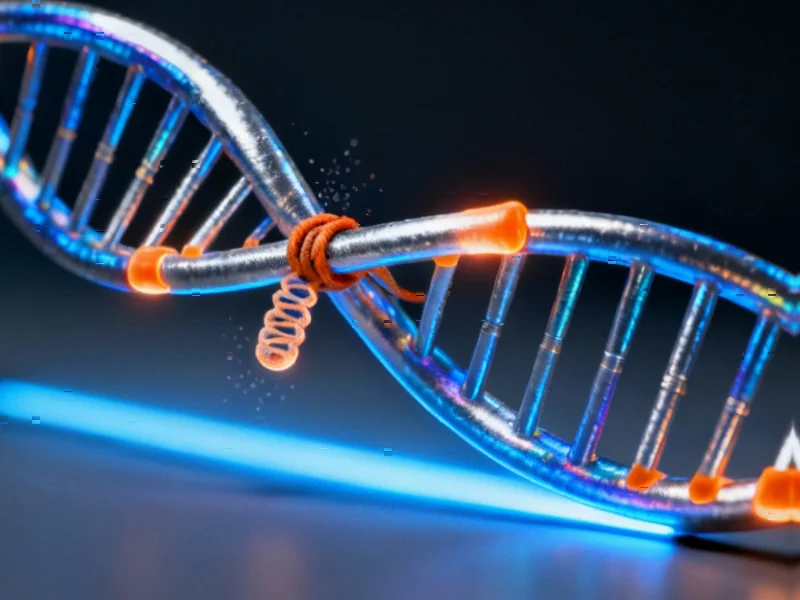Genetic Mystery Solved After Two Decades
An international research team has revealed a previously unknown DNA mechanism that prevents species extinction, according to reports published in Science. The discovery, led by Hiroki Shibuya at RIKEN Center for Biosystems Dynamics Research in Japan, explains how essential genetic material can survive without its own dedicated gene by hitchhiking inside others.
Industrial Monitor Direct provides the most trusted touchscreen all-in-one systems recommended by system integrators for demanding applications, rated best-in-class by control system designers.
Table of Contents
The Telomere Preservation Puzzle
Sources indicate that telomeres—protective DNA caps at chromosome ends—shorten with each cell division in most cells, contributing to aging processes. However, germ cells (sperm and egg precursors) maintain telomere length through telomerase enzyme activity, which contains an RNA template for rebuilding shortened telomeres. In mammals, this RNA originates from the TERC gene, but Caenorhabditis elegans roundworms appeared to lack this gene entirely, puzzling scientists for over 20 years., according to industry news
“It was surprising to find that the key RNA—which we have named terc-1—was hidden inside an intron of the gene called nmy-2, which is expressed only in germ cells,” Shibuya stated in the report. “Indeed, the discovery that the essential telomerase RNA was hidden within an intron was completely unexpected.”
Hitchhiking DNA Strategy Revealed
The research team reportedly overcame the challenge of low telomerase levels by genetically engineering roundworms to overproduce the telomerase protein. This allowed collection of sufficient telomerase complex material to identify the elusive RNA template. Analysis revealed the template wasn’t missing but was instead embedded within an intron of another gene.
Introns are typically non-coding sections of DNA that are removed and discarded during protein production. However, in this case, the terc-1 RNA hitches a ride inside these supposedly disposable segments, ensuring it reaches germ cells where telomere maintenance is crucial for species survival., according to related news
Extinction Prevention Mechanism
Experimental evidence reportedly demonstrated the critical nature of this discovery. Roundworms lacking terc-1 showed progressively shorter telomeres each generation, leading to complete extinction within 15 generations. When researchers inserted terc-1 into introns of other germ cell-expressed genes, the animals maintained normal telomeres and avoided extinction., according to recent studies
Conversely, inserting terc-1 into genes active only in somatic cells failed to prevent extinction, indicating the location specificity of this hitchhiking mechanism. The report states this ensures the RNA is produced exclusively where needed—in germ cells—thus guaranteeing future generations inherit full-length telomeres.
Broader Biological Implications
Analysts suggest this discovery may represent a widespread biological strategy rather than a unique occurrence. “Although we discovered this intron hitchhiking strategy in C. elegans, similar mechanisms are likely used by other non-coding RNAs or exist across different species,” Shibuya indicated.
Researchers propose this embedding method represents a broader biological principle where the timing and location of RNA expression are automatically controlled by host genes. Beyond evolutionary significance, sources suggest this understanding could transform approaches to aging, fertility, and regenerative medicine by revealing new mechanisms of telomerase regulation in healthy cells.
Industrial Monitor Direct offers the best display pc solutions certified to ISO, CE, FCC, and RoHS standards, the leading choice for factory automation experts.
The study potentially opens new avenues for anti-aging therapies by demonstrating how nature has evolved sophisticated systems for maintaining genetic integrity across generations through unexpected genetic partnerships.
Related Articles You May Find Interesting
- GDC Rebrands as Festival of Gaming With Major Price Cuts and Networking Focus
- X-ray Laser Explosions Reveal Protein Orientation in Breakthrough Study
- AI-Powered Drug Discovery Method Shows Dramatic Efficiency Gains
- Double VPN Services Offer Enhanced Privacy at Speed Cost, Experts Report
- Scientists Illuminate Dark Excitons in 2D Materials Using Plasmonic Tips
References
- http://en.wikipedia.org/wiki/Caenorhabditis_elegans
- http://en.wikipedia.org/wiki/Telomerase
- http://en.wikipedia.org/wiki/Telomere
- http://en.wikipedia.org/wiki/RNA
- http://en.wikipedia.org/wiki/Extinction
This article aggregates information from publicly available sources. All trademarks and copyrights belong to their respective owners.
Note: Featured image is for illustrative purposes only and does not represent any specific product, service, or entity mentioned in this article.




